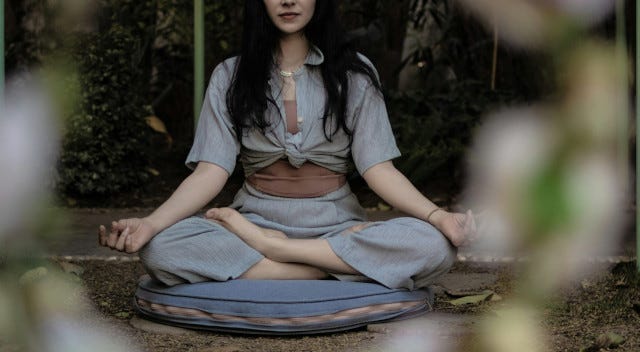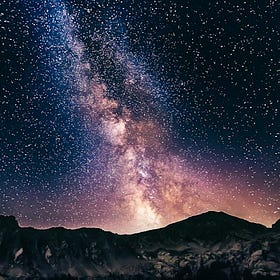What I learned from my 10-days Vipassana meditation retreat
Struggles, breakthrough, lessons from the monks and an epiphany.
Reading ’s silent meditation retreat experience transported me back to mine about a decade ago. This is a reflection of my 10-day Vipassana meditation retreat, which happened ten years ago. Coincidentally, a decade anniversary made it an excellent time to ponder. At the moment, I am struggling to keep up the practice in my daily life, but writing this has helped me recenter myself and given me the confidence and tools to incorporate it back again.
The first three days were simply torture.
“Learning by doing!” the monk assigned to oversee us, “foreigners,” roared with command at our start. Initially, I was perturbed by his harshness, but later, I appreciated his bluntness and matter-of-fact way of speaking. In hindsight, I surmise it could also be due to the language barrier.
So, I started to learn meditation by doing. We were told to alternate sitting and walking while concentrating on our breath with a 10-minute interval. I ended up spending every minute struggling not to fall asleep. Years later, my best friend would tell me that our mind shuts down by falling asleep to protect ourselves from what is uncomfortable. I was even falling asleep during the walking meditation. Yes, one can fall asleep while walking.
Not only was my mind shutting down, but it was also in heated discourse with itself.
“Why did I come here? What am I doing? How will I do this for ten days?”.
“Quiet! It’s just starting, and you are giving up.”
In this resistance, I saw a reflection of how we innately resist change in life. Gradually though, the sleepiness faded and I made peace with myself for taking up this seemingly meaningless and torturous endeavor. But my mind remained restless.
Day three rolled along, or was it day 4? Time is flowing in a different direction.
I sighed and silenced the 10-minute timer. Another failed attempt. I was in my favorite part of the temple grounds—a square fenced compound surrounded by trees, with the gate flanked by two giant Buddha statues—a place one has to evacuate once the sun sets and the swarm of mosquitoes descends upon it. I stared at the Buddha on the right.
That was when the inspiration struck me.
I took on the half-lotus position of that Buddha—my left foot pressed gently on my right knee while I stretched my spine upward, shoulders pulling back slightly, my face relaxing as the lips moved to half smile. It was a breakthrough. From then on, I always assumed this position, and a sense of peace would ground me as I began my meditation practice.

A decade later, I would read from Thich Nahn That about the Buddha position:
“Sitting on the same spot as a Buddha gives rise to happiness and sitting in mindfulness means itself to have become a Buddha.” 1
How this position came to me will remain unknown. Was the universe speaking to me, or did I unearth an ancient wisdom because I was trying and looking hard enough?
After the breakthrough, I looked forward to every session, increasing the length of my meditation and battling my thoughts step by step. Towards the latter part of the retreat, I clocked in 10 hours of meditation each day, and in one of our daily check-ins with one of the monks, I proudly announced it. To which he responded matter-of-factly, “You need to sleep less.”
In one of these sessions, I also told him how I noticed my thoughts flit from memory to memory, like electricity passing through a gigantic grid of networks, flowing from one line to another with the thinnest of connecting threads.
He said, “There are two types of people—one who thinks about the past, another the future.” I do not usually dwell in the past or let any what-ifs or regrets bog me down, but it seems my carefreeness about the future was so strong that even my wild mind wouldn't care to venture there.
Besides discussions, the monk also taught me the following steps to advance my meditation practice each time:
Center on the breath—breathe in, breathe out.
On the next pair of breaths - imagine/acknowledge where you are—the garden, the temple, the world.
Repeat.
As the days passed, instead of imagining where we were, we began to “touch” different points in the body with the mind—first the left shoulder, then the right, and onwards to the hips and knees.
Soon, a strange yet mesmerizing pulse appears at each spot that I “touch,” as if my heart were beating through these areas, following me from spot to spot, deepening my awareness of my body.
This meditation dance with myself was so calming that I was reluctant to have it end when the last day rolled in. One lady from our group will continue for 20 days—this is her second time—and I was tempted to follow. But in the end, I decided to stick with the plan. Besides, my family and friends would wonder where I am if I didn’t get in touch since our disconnection at the start.
For our Vipassana retreat, we had to surrender all our possessions. They cut us off from connecting with the outer world by taking away our devices. They cut some of us off from connecting with our thoughts by taking our paper and pen. They also cut us off from worldly attachments by taking our clothes and other manners of beautifying ourselves and not providing a mirror in our bathrooms.
We were given white robes to wear. We have a 2-inch mattress on a wooden bed and a bathroom with cold water running from a pipe. That was all we needed.
Each morning, the bell rings to signal wake time and meal times—5 a.m., 6 a.m., and 1 p.m. After that, we fast until the next day. I have never felt more energized in my life with this restricted eating. Granted, there was no stress or need to attend to daily life. Our only task was to wash our dishes after the meal and the voluntary sweeping of fallen leaves. There was also no need—in fact, it was forbidden—for social interactions.
All that mattered was the meditation—doing nothing, thinking nothing, and needing nothing.
With routine, my meditation practices melted into each other. My grip on my mind grew stronger, keeping it in the present longer and longer. Soon, deeper contemplations emerged, and I asked the monks questions like, “Is there reincarnation?” In other words, what happens when we die?
“Look at this flame,” the monk said, holding up a lit candle. He then lit another candle with it and, gesturing to the new flame, asked, “Is it still the same fire?”
I bit my lip and ventured a guess. “It was for the first second, and then it isn’t anymore.” He just smiled.
I returned to my meditations, sitting erect in the lotus position.
Breathe in. Breathe out. Touch. Breathe in. Breathe out. Touch.
As I sat in stillness, I thought of the flame, symbolizing life itself—ever-shifting, ever-moving. Each moment lit the next, seemingly without separation. Slowly, the boundaries of time unraveled before me. There was no past or future, only this moment—my breath, the hard ground beneath me, the stillness in my body.
Then, as if waking from a dream, it hit me—there is no time. There is only now.
Also, you may like these:
Why conscious living is the key to happiness
The Miracle of Mindfulness by Thich Nhat Hanh.





I did a couple Vipassana retreats a few years ago as well. Probably one of the hardest things I've ever done! But I learnt so much and I really do believe that the things I've learnt have formed the foundation to my later life.
I've been intrigued by the idea of a Vipassana retreat, but haven't felt able to do it yet! Thank you for sharing your experience and the insights you came away with - the monk's question and your reflection on the fire and the flame, and human-made vs natural concepts of time, are particularly profound. I'm going to keep sitting with them. I love this piece! Thank you for sharing!